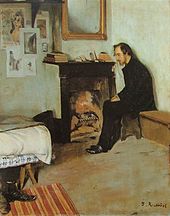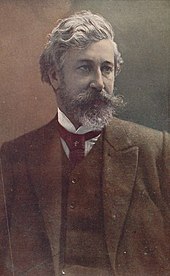Santiago Rusiñol


Santiago Rusiñol i Prats (born February 25, 1861 in Barcelona , † June 13, 1931 in Aranjuez ) was a Catalan painter, writer, journalist and playwright. He was one of the most outstanding and productive artists of Modernism .
Life
As heir to a dynasty of textile manufacturers from Manlleu , Rusiñol had a career in the family business that he gave up at the age of 28 to devote himself entirely to art. To study painting, he went to Paris (leaving behind his wife and child) , where he lived in Montmartre from 1889 to 1893 . He trained in painting plein air and exhibited his first works together with other Spanish and Catalan artists - such as his friends Ramon Casas and Ignacio Zuloaga . It was around this time that he also began writing and regularly published articles in the Spanish newspaper La Vanguardia .
His financial situation allowed him to travel extensively. He led the life of a bohemian who could give himself completely to l'art pour l'art . After his return to Catalonia, he founded the workshop-museum Cau Ferrat (“Iron Cave”) in the small coastal town of Sitges near Barcelona , in which he built a large collection of traditional wrought iron art. It became an important meeting point for artists. In Barcelona, Rusiñol was a frequent guest in the café-restaurant Els Quatre Gats ("The Four Kats"), where he met the young Pablo Picasso and other artists and organized numerous exhibitions and readings. Rusiñol i Prats died in 1931 and is buried in the Cementiri de Montjuïc in Barcelona.
plant
Rusiñol's painting is strongly influenced by Impressionism and initially comprises a wide variety of themes - rural as well as urban scenes, portraits as well as symbolic compositions. From 1894, a destructive addiction to morphine determined his life and work. Some of his most famous paintings date from this period, such as La morfina ("The Morphine Addict ") and La medalla ("The Medal"). After a withdrawal treatment in 1899, he turned to a completely new subject, to which he remained true to the end of his life: gardens and parks, which he almost always depicted deserted. For this he traveled to Mallorca , Ibiza , Valencia , Girona , Cuenca and Aranjuez, among others .
In addition to painting, Rusiñol also wrote intensively. For example, in his gloss for the newspaper L'Esquella de la Torratxa from 1907 to 1925, under the pseudonym Xarau, he had a long-lasting, eloquent exchange of blows with the writer Eugeni d'Ors , who wrote under the name Xènius in the newspaper La Veu de Catalunya had become one of the most popular representatives of the Noucentisme , a current of Catalan cultural life that emerged at the beginning of the 20th century as a countermovement to Modernisme . In addition, Rusiñol wrote numerous books and plays.
Written work in selection
- 1894 Desde el Molino ("From the Mill") - book
- 1900 El jardí abandonat ("The Abandoned Garden") - play
- 1901 Llibertat! ("Freedom!") - play
- 1902 El malalt crònic ("The Chronically Ill") - play
- 1906 La bona gent (“The good people”) - play
- 1907 L'auca del senyor Esteve ("The Story of Mr. Esteve") - play
- 1911 Del Born al Plata ("From the Born to the Rio de la Plata") - book
- 1912 Glossary ("Glossen") - book
- 1913 Màximes i mals pensaments (“Maxims and Evil Thoughts”) - book
- 2013 Mallorca - the island of calm - published by Hartmut Siefeldt, paperback and e-book, travel book publisher, Plön
Web links
| personal data | |
|---|---|
| SURNAME | Rusiñol, Santiago |
| ALTERNATIVE NAMES | Rusiñol i Prats, Santiago (full name); Xarau |
| BRIEF DESCRIPTION | Spanish painter, writer, journalist, collector and playwright |
| DATE OF BIRTH | February 25, 1861 |
| PLACE OF BIRTH | Barcelona |
| DATE OF DEATH | June 13, 1931 |
| Place of death | Aranjuez |

